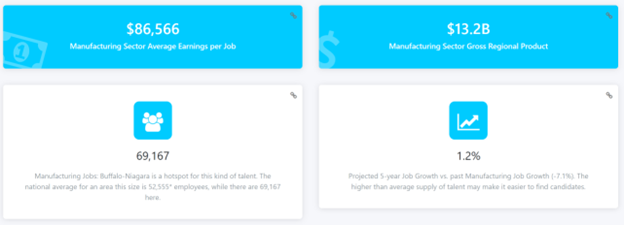Buffalo Niagara’s advanced manufacturing ecosystem employs nearly 70,000 members of our community and has a gross regional product of $13.2 billion. Economic data points are critical in helping companies – and communities – make critical investment decisions and inform strategic development efforts.
To help our community grow, we have built a dynamic dashboard profiling the Buffalo Niagara advanced manufacturing industry.
“Advanced manufacturing is a key target industry identified by Buffalo Urban Development Corporation (BUDC) Chairman, Mayor Byron W. Brown. This dashboard allows BUDC to better connect and collaborate with various groups to both strengthen Buffalo’s diverse workforce and leverage innovative educational training programs such as those offered at the Northland Workforce Training Center," said Becky Gandour, Executive Vice President of BUDC. "By better understanding the demands of our community, we can accelerate change that furthers the Buffalo Niagara region’s economic growth and sustainability.”

What Does This Dashboard Show?
Buffalo Niagara advanced manufacturing sector has 31.6% more jobs than a typical region of our size. While other regions are experiencing a decline in manufacturing jobs by over 7%, Western New York is growing. These aren’t your grandparents’ factories, either. Production-level jobs are more specialized and complex which has brought a combination of safety and higher wages. Non-production occupations, such as engineers and tech jobs, are increasingly prevalent as the products our manufacturers make become smarter and more resilient. For example, the Economic Impact our food processing operations have on the rest of our region create 2-5x as many jobs as they employ alone. Manufacturing does not just build products, it builds the Buffalo Niagara economy.
How Might We Use These Data?
This dashboard will inform our understanding of the Buffalo Niagara advanced manufacturing sector. This can help us all explain what kind of work is available and which sub-sectors in manufacturing are our strengths. We can also identify our needs for specific types of workers and recognize the lower inclusion rates of specific groups in our community.
"Having data is one thing; communicating it for a broad audience is a whole other challenge. With its new Manufacturing Dashboard, InBN joins communities across the U.S. from College Park, MD, to Austin, TX, to Orange County, CA, that have discovered the power of using data visualization to help drive outcomes in the labor market and economic prosperity," said Erik Larson, CEO of eIMPACT. "In particular, by publishing a transparent picture of diversity within manufacturing occupations, InBN can foster conversations and forge partnerships based on hard data delivered in a clear format."
For example, Buffalo Niagara’s advanced manufacturing sector has 3x as many job postings than it had 5 years ago. We can meet a large portion of this increased demand by matching occupational participation rates more closely to our region’s demographic diversity. Perhaps most importantly, our local workforce training ecosystem can leverage the data on specific occupation needs to advance programming which generates those skills – and collaborate with community partners to recruit students from neighborhoods underrepresented in manufacturing.
What’s Next?
Invest Buffalo Niagara will be highlighting some key data points over the next few months and how the data relate to specific initiatives going on in Buffalo Niagara. InBN is currently undergoing a Labor Market Assessment (LMA) with recommendations being released in the Fall. The LMA will also highlight best practices from elsewhere in the US which can help us strengthen our manufacturing workforce pipeline.
With this data and dashboard, we can now see where we’re at. Now it is time to use this data to inform where are going next.
About the dashboard
In December 2021, the Buffalo Niagara region was named a finalist for the Economic Development Administration’s (EDA) Build Back Better Regional Challenge. This designation was awarded for a reason: the strength of our advanced manufacturing industry.

